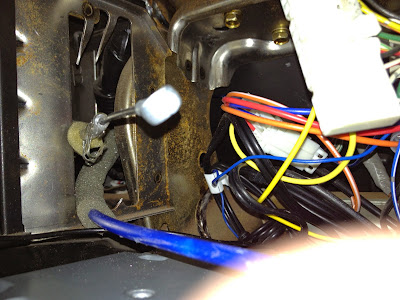Author: wtbman
Trailer – Rebuilding the floor – foam insulation – floor joist design
Trailer – Replacing bottom of walls – new subfloor structure
Trailer – We found the ROT!! – Disassembly & new items
Trailer – Appliances – Before Pictures
Trailer – Bringing home the trailer – Before Pictures
Today we brought home the trailer… It’s a 1984 Petersen Excel 22′ travel trailer. It seemed like it was in pretty good shape with the exception of knowledge that the hot water heater had exploded and needed replacement. Well we were very wrong about the trailer being in good shape as you will see in pictures in future blog posts.
Before:
Fix For: Keyboard Stops Working on Windows 8.1
Found an awesome fix at:
https://deploymentramblings.wordpress.com/2014/05/05/keyboard-stops-working-on-windows-8-1-system/
I was working on a client’s system and after I had disabled a few annoying things like the narrator I couldn’t get the keyboard to work anymore. After a search on the internet I found that there was still one setting enabled:
After I switched off “Filter Keys” the keyboard magically started working again. Thanks deploymentramblins!
Fix for: Can’t activate Outlook 2015 on Mac “Another account from your organization is already signed in on this computer.”
Installed Pioneer DEH-P7400HD & relocated HVAC climate controls – Eclipse 3G
I have yet to see a picture or thread on this so I didn’t know if it was possible. I am here to tell you that it is, and that it is easy. I relocated the HVAC controls up one din so my radio controls would be at easy reach while resting my hand on the shifter. It’s almost exactly how nice it was in my 1st gen Eclipse.
I had to make a custom bracket to mount the head unit to. I happened to have the factory mounting brackets from a 1st gen Eclipse. You can see one of the four spot welds I made in this picture. You could just drill through and bolt them together if you don’t have a welder. The donor bracket was contoured almost perfect to slide into the contours of the factory bracket.

TomatoUSB 1:1 NAT for Qwest 8 static ip block
This isn’t what I want yet, but I may be closer to true routing where the router actually routes my ip addresses. I’ll be sure to post what I find out.
For now, these are commands you need to run if you wish to do a 1:1 NAT setup on your tomato/dd-wrt/*wrt router firmware (or most things linux for that matter)
I have a block of 8 static IPs from Qwest/CenturyLink and in this configuration you can use all 8 (minus one for the router). Notice I skipped 14 because that address is the router’s. Your exact configuration may vary but substitute your addresses as necessary. I used a 10.10.10.0 private network. The static IPs are mapped to a corresponding private IP address.
First section assigns the ip addresses to the router.
Second section does network address translation, so websites or services you connect to on the internet will show the associated static/public ip.
Third section maps incoming traffic to the associated address on your private network, this will allow you to login/access the devices by the associated public ip address.
Fourth section will open ALL ports incoming to the specified internal ip address. This will defeat all firewall rules on the router. Only do this if you are going to run firewall software on those machines. Lookup more information on how to block/enable ports for iptables to enable specific ports.
Here is the config:
ip addr add XXX.XXX.XXX.8/29 dev ppp0ip addr add XXX.XXX.XXX.9/29 dev ppp0ip addr add XXX.XXX.XXX.10/29 dev ppp0ip addr add XXX.XXX.XXX.11/29 dev ppp0ip addr add XXX.XXX.XXX.12/29 dev ppp0ip addr add XXX.XXX.XXX.13/29 dev ppp0ip addr add XXX.XXX.XXX.15/29 dev ppp0iptables -t nat -I POSTROUTING 1 -p all -s 10.10.10.8 -j SNAT --to XXX.XXX.XXX.8iptables -t nat -I POSTROUTING 1 -p all -s 10.10.10.9 -j SNAT --to XXX.XXX.XXX.9iptables -t nat -I POSTROUTING 1 -p all -s 10.10.10.10 -j SNAT --to XXX.XXX.XXX.10iptables -t nat -I POSTROUTING 1 -p all -s 10.10.10.11 -j SNAT --to XXX.XXX.XXX.11iptables -t nat -I POSTROUTING 1 -p all -s 10.10.10.12 -j SNAT --to XXX.XXX.XXX.12iptables -t nat -I POSTROUTING 1 -p all -s 10.10.10.13 -j SNAT --to XXX.XXX.XXX.13iptables -t nat -I POSTROUTING 1 -p all -s 10.10.10.15 -j SNAT --to XXX.XXX.XXX.15
iptables -t nat -A PREROUTING -p tcp -d XXX.XXX.XXX.8 -j DNAT --to-destination 10.10.10.8iptables -t nat -A PREROUTING -p tcp -d XXX.XXX.XXX.9 -j DNAT --to-destination 10.10.10.9iptables -t nat -A PREROUTING -p tcp -d XXX.XXX.XXX.10 -j DNAT --to-destination 10.10.10.10iptables -t nat -A PREROUTING -p tcp -d XXX.XXX.XXX.11 -j DNAT --to-destination 10.10.10.11iptables -t nat -A PREROUTING -p tcp -d XXX.XXX.XXX.12 -j DNAT --to-destination 10.10.10.12iptables -t nat -A PREROUTING -p tcp -d XXX.XXX.XXX.13 -j DNAT --to-destination 10.10.10.13iptables -t nat -A PREROUTING -p tcp -d XXX.XXX.XXX.15 -j DNAT --to-destination 10.10.10.15
iptables -I FORWARD -p tcp -d 10.10.10.8 -j ACCEPTiptables -I FORWARD -p tcp -d 10.10.10.9 -j ACCEPTiptables -I FORWARD -p tcp -d 10.10.10.10 -j ACCEPTiptables -I FORWARD -p tcp -d 10.10.10.11 -j ACCEPTiptables -I FORWARD -p tcp -d 10.10.10.12 -j ACCEPTiptables -I FORWARD -p tcp -d 10.10.10.13 -j ACCEPTiptables -I FORWARD -p tcp -d 10.10.10.15 -j ACCEPT
Here’s some more information I found:
Setting up DMZ with multiple static IPs on an office LAN using DD-WRT :: Things n’ Stuff
PLANEX COMMUNICATIONS INC.
!!!!!!! DD-WRT Forum :: View topic – multiple external IP addresses
Default internal device network – DD-WRT Wiki
VLAN Detached Networks (Separate Networks With Internet) – DD-WRT Wiki
Multiple public IPs with one router using DD-WRT Configure Static Routes In Debian or Red
Hat Enterprise Linux
Two isolated separate LAN subnets and rate limiting. – TomatoUSB
OpenWRT Linksys WRT54G for 5 static IP Service Ameritech – SBC FAQ | DSLReports.com, ISP Information




